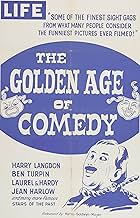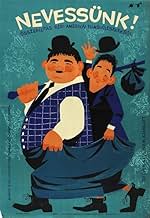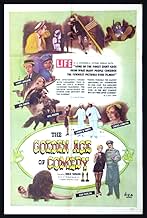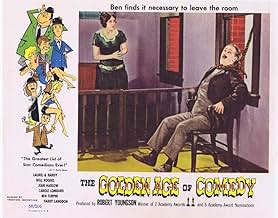NOTE IMDb
7,1/10
512
MA NOTE
Ajouter une intrigue dans votre langueA compilation of scenes featuring some of the best-known comics from the silent era in their best films.A compilation of scenes featuring some of the best-known comics from the silent era in their best films.A compilation of scenes featuring some of the best-known comics from the silent era in their best films.
- Réalisation
- Scénario
- Casting principal
Stan Laurel
- Stan
- (images d'archives)
- (as Laurel)
Oliver Hardy
- Ollie
- (images d'archives)
- (as Hardy)
Ben Turpin
- Rodney St. Clair
- (images d'archives)
Andy Clyde
- Andy
- (images d'archives)
Edgar Dearing
- Policeman at Car Fight
- (images d'archives)
Madalynne Field
- Fat Girl Track Competitor
- (images d'archives)
Avis à la une
Personally, I wasn't all that keen on Chaplin, so his omission here doesn't bother me as it seems to others? Robert Youngson probably just never had the rights to use any of the material from those left out, although Keaton and Chaplin appeared in his next compilation. This is priceless entertainment, I think the music and added sound effects make these clips all the more enjoyable, plus the very witty and informative narration. Stan & Ollie are the standouts of course, for me the lengthy 'Two Tars' clips are the best, and the rest isn't far behind! Don't analyse it, just enjoy!
Robert Youngson's first big compilation of silent comedy clips holds an important place in the history of film. Before this film, silent films were viewed as creaky antiques, suitable only for the occasional sneering jeer, like the "Goofy Movie" series and the rare fond memory of old-timers. It was only beginning in 1949, with Walter Kerr's article on the "Four Greats" of silent comedy, that a reappraisal began.
If, as some reviewers complain, there is no Lloyd, Keaton or Chaplin available here, well, their place was already being reestablished or, in Chaplin's case, had never been questioned. If the movie begins with a series of clips from the Sennett studios, it was surely Sennett's reputation which had sunk lowest, until he was recalled only as a purveyor of primitive pie fights in worn-out prints. Here, Youngson offers them in clean copies with admiring voice-overs and good musical accompaniment. If they're not the way the audience was intended to see them -- as complete films -- this surely shows them off to advantage as they had not been seen in thirty years. If nowadays the purist sneers at the film's perceived shortcomings, he should recognize that without Youngson's daring and surprisingly successful offering here, that purist would probably have never heard of those talents; given that almost all that survives of the Laurel & Hardy THE BATTLE OF THE CENTURY exists only because Youngson put most of its second reel here....
If, as some reviewers complain, there is no Lloyd, Keaton or Chaplin available here, well, their place was already being reestablished or, in Chaplin's case, had never been questioned. If the movie begins with a series of clips from the Sennett studios, it was surely Sennett's reputation which had sunk lowest, until he was recalled only as a purveyor of primitive pie fights in worn-out prints. Here, Youngson offers them in clean copies with admiring voice-overs and good musical accompaniment. If they're not the way the audience was intended to see them -- as complete films -- this surely shows them off to advantage as they had not been seen in thirty years. If nowadays the purist sneers at the film's perceived shortcomings, he should recognize that without Youngson's daring and surprisingly successful offering here, that purist would probably have never heard of those talents; given that almost all that survives of the Laurel & Hardy THE BATTLE OF THE CENTURY exists only because Youngson put most of its second reel here....
10Petey-10
In 1957 Robert Youngson directed The Golden Age of Comedy which is a documentary with clips from the silent movies with our favorite comedians.You can see Stan Laurel and Oliver Hardy as jail birds who escape and they have to prove that they are painters.And in one clip Laurel and Hardy are having problems with cars and especially with the ones who are driving them.And who could forget the legendary pie throwing scene.The baby face Harry Langdon, offers lots of funny moments in the train.Billy Bevan and Mack Sennett's Cameo dog are hilarious.There are also clips from actors such as Will Rogers, Carole Lombard, Jean Harlow and the cross eyed Ben Turpin.For true silent comedy lovers it is impossible to get bored with The Golden Age of Comedy.Watch these golden clips from the silent era and have fun!
From the age of the Pie Fight comes this marvellous compilation by Robert Youngson.Watching it you can judge how much sheer joie - de vivre has been lost with the so - called "sophistication "of movie comedy in the ensuing decades.And where are the geniuses to rival Mr Chaplin and Mr Keaton?Who,today,is as universally loved as Mr Laurel and Mr Hardy whose masterwork "Big Business" is featured here? Feel free to laugh uproariously....."For Ghosts may be listening." "The Golden Age of Comedy" used to be a staple of Christmas Day TV. Sitting there watching it with a mince pie and a glass of port must be the nearest thing to paradise this side of the Elysian Fields.
This well-meant but misleading compilation celebrates the glory days of silent film comedy, for the most part through mediocre excerpts from the Max Sennett and Hal Roach Studios, which even at their peak could never match the sophistication of a Chaplin, Lloyd, or Keaton two-reeler. The repertory of Sennett and Roach gags rarely extended beyond mild parody, primitive slapstick, and artificial trick effects, giving an entirely false but lasting impression of silent comedy as nothing but frantic pratfalls and pie fights. The exception here is Laurel and Hardy, whose deliberate methods of wreaking mayhem overturned the time honored formula of fast and furious chases. Happily, the film gives them extra attention, but the majority of footage is devoted to second-rate clowns like Billy Bevan and cross-eyed Ben Turpin. Even the great Harry Langdon is represented only in a clip from a minor Sennett short which gives little indication of his unique talents, and the enthusiastic voice-over narration underlines his lackluster antics with forced wit and too many puns.
Le saviez-vous
- GaffesThe narrator cites a clip of Laurel and Hardy as coming from "We Slip Up." Laurel and Hardy never made a movie with that title. The actual movie referenced is On a gaffé (1928).
- Versions alternativesThere is an Italian edition of this film on DVD, distributed by DNA Srl: "CAVALCATA DELLA RISATA (1957) + LA BOMBA COMICA (Ça c'est du cinéma, 1951)" (2 Films on a single DVD, with "Ça c'est du cinéma" in double version, with alternative cut titled "I terribili antenati di James Bond"), re-edited with the contribution of film historian Riccardo Cusin. This version is also available for streaming on some platforms.
- ConnexionsEdited from Andoche fait du ciné (1923)
Meilleurs choix
Connectez-vous pour évaluer et suivre la liste de favoris afin de recevoir des recommandations personnalisées
Détails
- Date de sortie
- Pays d’origine
- Langue
- Aussi connu sous le nom de
- The First Kings of Comedy
- Voir plus de crédits d'entreprise sur IMDbPro
- Durée1 heure 19 minutes
- Couleur
- Mixage
- Rapport de forme
- 1.33 : 1
Contribuer à cette page
Suggérer une modification ou ajouter du contenu manquant

Lacune principale
By what name was La Grande Époque (1957) officially released in Canada in English?
Répondre



































